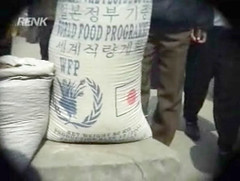More Food Aid Diversion?
I’m shocked, shocked. DailyNK, which has just published another of my pieces, claims that there is video of Japanese food aid for sale in the markets. It’s not the first time we’ve heard reports of this kind, accompanied by video. Update: No link to the video yet, but here’s a still:
 It certainly must have taken some cojones to spend a month inside North Korea with a camera, acting as an agent of a dissent or anti-regime group. Photo credit here goes to the Japanese NGO RENK, which has sent cameramen into North Korea before, and which has some fascinating stuff on its site.
It certainly must have taken some cojones to spend a month inside North Korea with a camera, acting as an agent of a dissent or anti-regime group. Photo credit here goes to the Japanese NGO RENK, which has sent cameramen into North Korea before, and which has some fascinating stuff on its site.
A month ago, a part of me would have said that even when food aid is diverted, it still drives down the price of food. Now, I’m not so sure. What’s changed my thinking is Andrew Natsios’s The Great North Korean Famine, which should be required reading for anyone who wants to understand conditions in North Korea today. Natsios explains that North Korea’s is now a hybrid economy. This means that there are two economies–one socialist and one capitalist–operating at the same time and place, but at completely different price structures. Contrary to most reports, which describe this as a new development, Natsios says it isn’t, and that these markets have been operating since 1945. He even quotes Kim Il-Sung as approving of their continued use until the government is capable of providing everything through the socialist public distribution system (PDS).
So is the PDS being replaced by the markets as increased supply fills demand? No.
Again, the key is North Korea’s class system, with the additional factors of “closed” areas and non-functioning enterprises that simply can’t afford to feed their workers. Counting these groups, somewhere around half the population that can’t afford to eat in the capitalist economy, meaning the PDS is their only sustainable alternative. The people in the lower classes can seldom go into business for themselves, due to government restrictions on benefits, travel, and commercial activities.
Meanwhile, high market prices are sucking food out of the socialist distribution system, whose prices can’t fluctuate with the market; thus, the PDS can’t provide an adequate supply and rations continue to fall. Why? Farmers devote all their energy to their private plots, steal and resell food, or dig up seed and sell it in the markets before it sprouts. Corrupt middlemen and officials take food intended for the public distribution system (PDS) and divert it to the market for outlandish profits. You can’t really blame the farmers for this; their kids are hungry, too.
At the same time, the government consistently fails to invest sufficiently in fertilizer, spare parts, and pesticides for agriculture, leading to lower yields. This doesn’t just affect North Korea’s domestic food production, either. The North Korean government forces the World Food Program to distribute all of its food aid through the PDS, which means more opportunities for state control, diversion, and corruption.
Of course, it’s easier to ask for fertilizer than for artillery, and of course, money not used for one can be used for the other.
And the result? Half the population again finds itself without food, forced to wander the forests for non-digestible grasses.